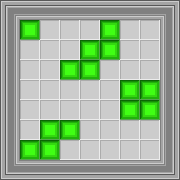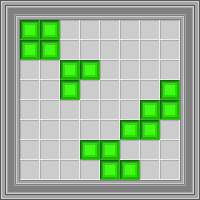Welcome to Blokus, a board game where you can place pieces of 1 to 5 blocks on a square board.
Each player has at his disposal every piece from monomino to pentomino.
A player's inventory is composed of 21 pieces, accumulating 89 squares in total :
All of these polyminoes are free, this means that you can rotate or flip them as you wish before placing them on the board.
The rules
Now what do we have to do in this puzzle ? Let's pick 2 natural numbers $k$ and $n$, and we'll try to place our pieces on a ($n*n$) square board to have exactly $k$ squares in each row and each column.
That gives us the following constraints :
- $0 < n$
- $0 < k \le n$
- $k*n \le 89$ (total number of placeable blocks)
Another rule is that each placed polymino musn't touch by the edge another polymino of the same color. It can however touch its corners, or the edges of an opponent's polymino.
For example, here are some possible cases of ($k,n$) done with 1 player :
(1,1) (2,2) (2,3) (2,4) (2,5) (3,5)
+- +-- +--- +---- +----- +-----
|P |BB |P W |VV |BB |LLL
|BB | WW |V W |BB |L VV
|WW | WW | WW | SS V
| WW | WW |SS T
| W P | TTT
Some example done with 2 players :
(3,3) (3,4) (4,4)
+--- +---- +----
|vvv |LLL |VVVp
|BBv |vv L |VzzQ
|BBv |v tL |VzQQ
| ttt |zzQQ
And some impossible cases for 1 player :
- ($n,n$) for $n>2$ : we would need a single piece of $n^2$ blocks (which is impossible), since any other piece that is composed of less blocks will create un-fillable blanks around its edges when placed.
- ($1,n$) for $n>1$ : you would need $n$ monominoes, which a single player has not in its inventory (and no, don't tear the blocks apart from others pieces, that's just brutal)
also :
- $k=4$, the 5-line piece can't be placed, total of placeable blocks for each player is $84$.
- $k=3$, the 4-line tetromino, the long L pentomino and the Y pentomino can't be placed either, this reduces the total placeable blocks for each player to $70$
- $k=2$, Only 6 pieces can be placed, and W is the only pentomino. total of placeable blocks for each player is $19$.
Scoring :
After completing a ($k,n$) board, the score will be evaluated as follows :
$$P = p1^2 + p2^2 + p3^2 + p4^2$$ $$Score = P/U * M$$
- $pX$ is the number of placed block from the inventory of player $X$
- $U$ is the number of players involved in completing the board (placed blocks > 0)
- For the record, $U>0$, because $k>0$
- Also, $U\le 4$
- $M$ is a bonus multiplier
- $M=1$ if $U=1$, or at least two pieces of different colors share an edge.
- $M=1.5$ if $U>1$ and no pair of pieces of any color share an edge.
The challenges :
- Maximize $(k,n) = (5, 10)$
- Maximize $(k,n) = (3, 20)$
I have found some scores on these that I believe can be optimized. But I'm actively trying to find out if the score on these 2 particular problems can or can not be completed using 1 player's inventory (which wields the best score)
And if you have found any perfect ($k,n$) boards (completed with only 1 player's set), don't hesitate to put them here.


















